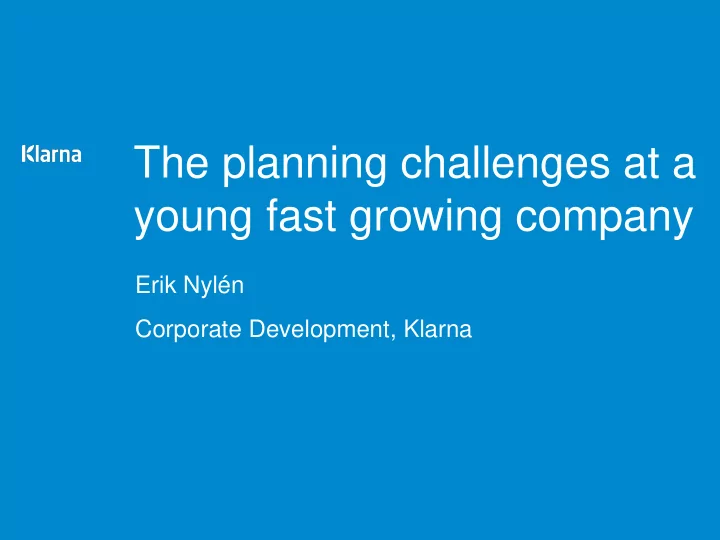

The planning challenges at a young fast growing company Erik Nylén Corporate Development, Klarna
This is the Klarna Group Founded in 2005, with a focus on simplifying buying • online World market-leader in after-delivery payments • € 4.6 billion transaction volume in 2013 • (FC € 7.1 billion in 2014) 45,000 online merchants across Europe • 25 million consumers • 15 countries • More than 1,100 employees • Main shareholders: Employees and Founders, • Sequoia Capital, General Atlantic, DST Global, and Atomico
Over 45,000 merchants love Klarna’s products
Business model Revenues Payment Merchants Consumers Purchases & direct method costs Things to be forecasted: • # of future, existing merchants • Consumer/Merchant behavior • Country • Segment • Etc. • Payment method distribution • Revenues & costs for payment methods
Previous forecasting model and requirements Requirements Old solution • An Excelmodel with 275 sheets 1. Accurate 1. Seasonality & trend • Based on a cohorts 2. Systematic approach for future and recently live merchants • Manual updating of data 2. Something more scalable: • A lot of manual labour • New countries • Prone to manual errors • New payment methods • New products • No adequate logic to handle both • Upselling and cannibalization seasonality and trend • Specifically relevant for merchants with 3. Quicker to update few data points Aggressive revenue estimations long- 4. Easy to maintain/develop further term 5. Understandable To high cost base as a result 6. Ability to slice and dice and do specific overrides
Project group We ended up having: • One internal project leader • 1-3 inhouse people • 1-2 SAS consultants • Easier to steer than a lot of external SAS consultants running around • You really need to understand the business to build a good solution • A lot cheaper
Result Requirements Result 1. Accurate 1. More accurate, MAPE decreased by 70% 1. Seasonality & trend 2. Much more scalable than prior Excel solution 2. Systematic approach for recently signed • Easy to add new countries merchants • Easy to add new payment methods • Slightly more difficult to add new products 2. Something more scalable: • Upselling between potential future products still • New countries requires development • New payment methods • New products 3. Quicker to update and forecast • Upselling and cannibalization • 20 minutes to update data • Full automation not worth time invested due to 3. Quicker to update frequent changes in system 4. Easy to maintain/develop further 4. A system possible to develop and maintain internally 5. Understandable 1. Modular 2. Know-how exists since internal project 6. Ability to slice and dice and do specific 3. SAS Enterprise Guide quite easy to learn overrides 5. Full ability to slice and dice forecasting data
Lessons learned • Business knowledge and time extremely vital in order to project lead • Spur the internal creative process, keep only a small amount of consultants for more complicated work (if possible) • Module management makes things scalable and easier to change • Deliver things in phases • A certain level of stability is required if automation should be worth it
Recommend
More recommend